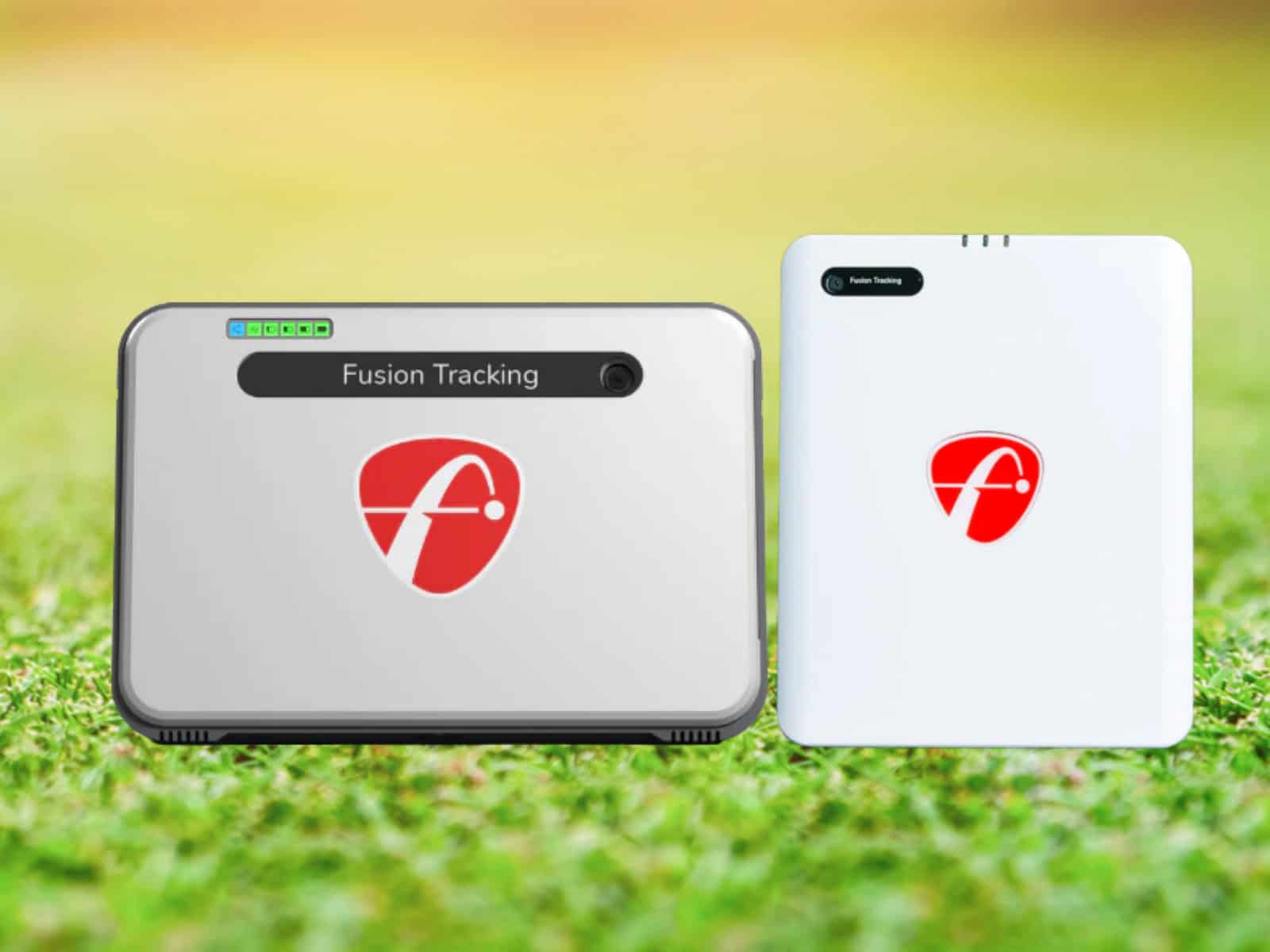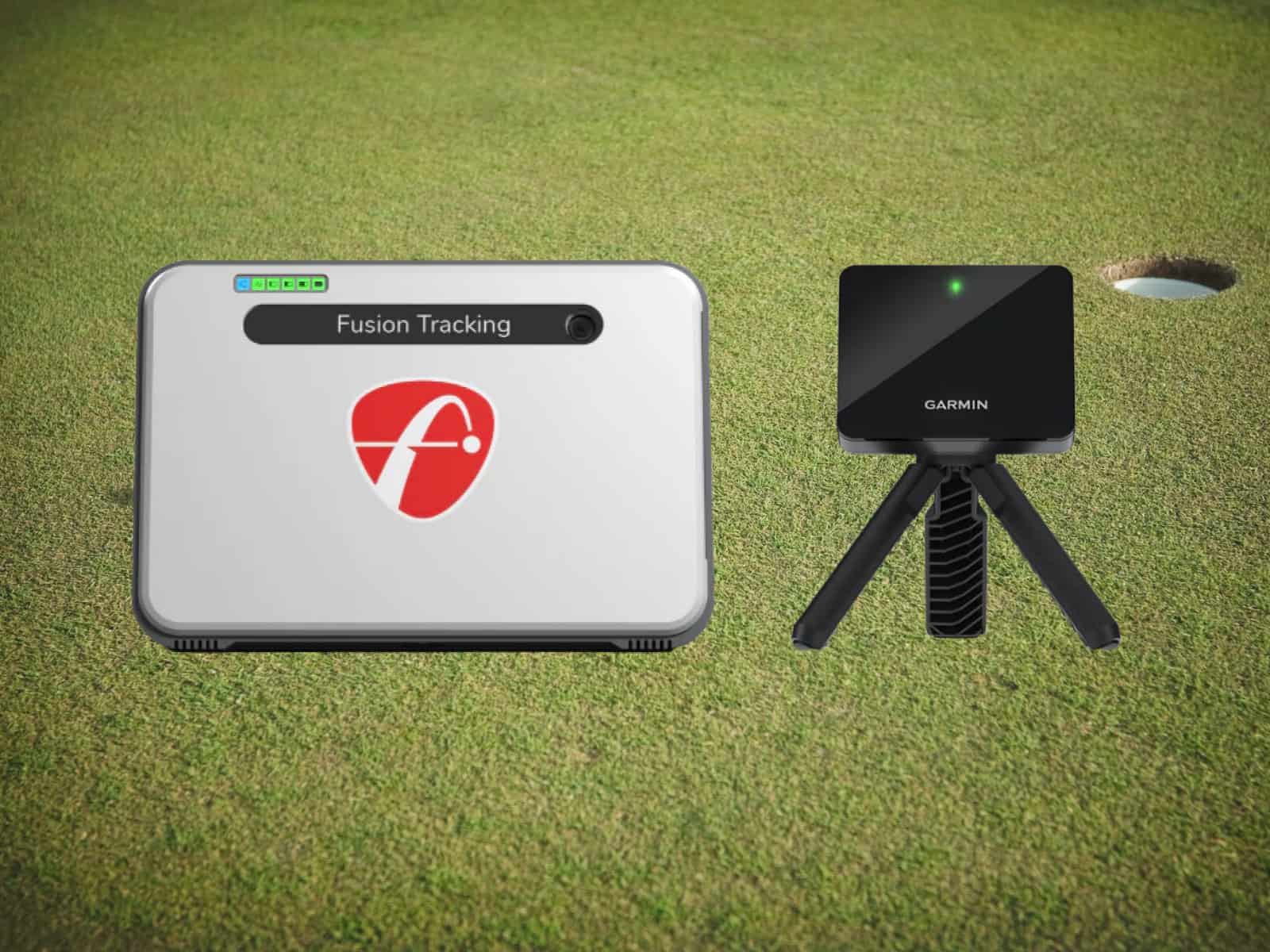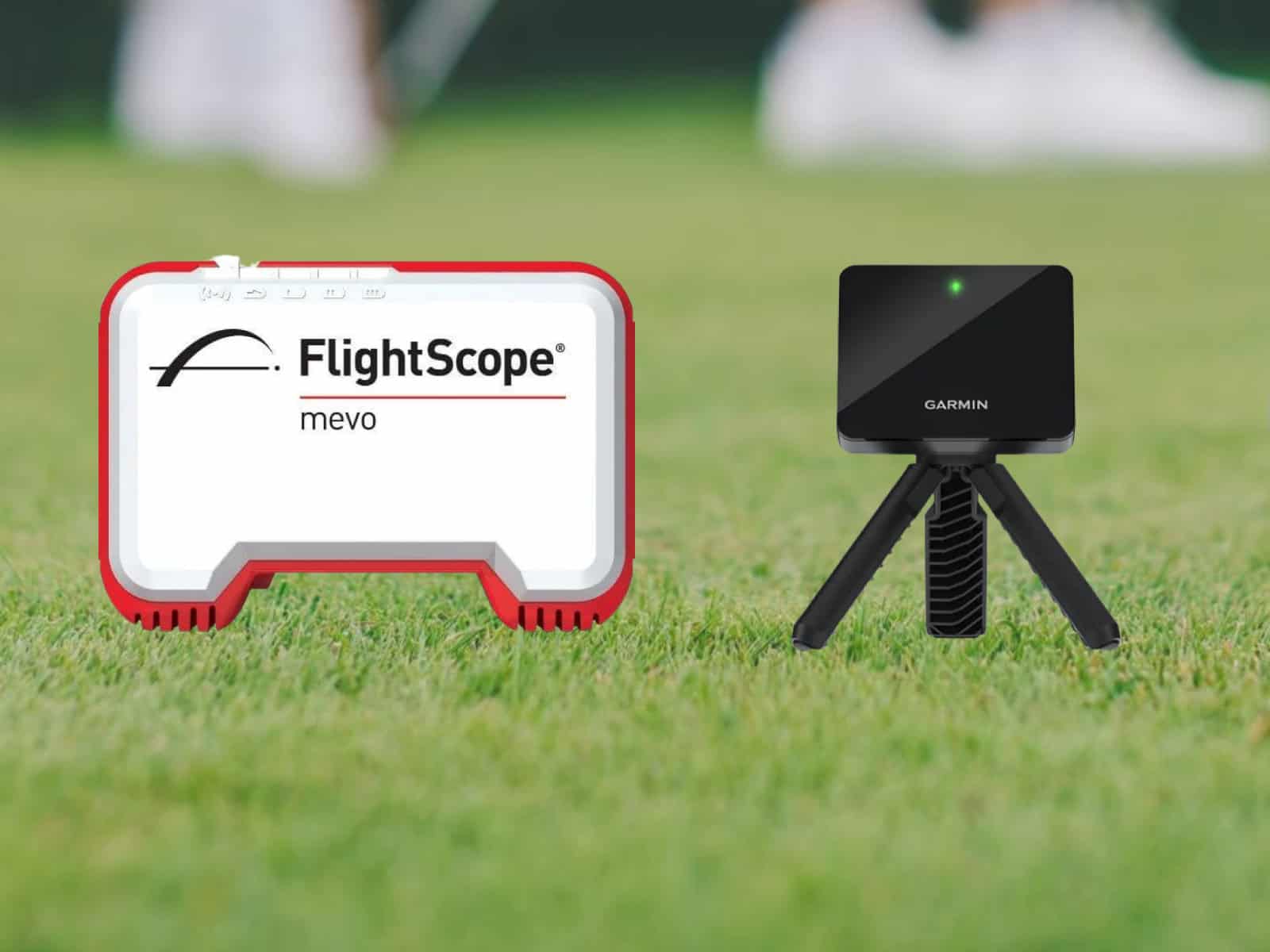TruGolf Mini and PhiGolf 2 are swing stick golf simulators built for tight spaces and tighter budgets. They don’t track the ball, and they won’t blow your socks off with realism, but they’re fun, portable and surprisingly functional for casual golfers.
In this guide, you’ll find a direct head-to-head comparison covering swing accuracy, software features, build quality, device compatibility, and who each one is best suited for.
Swing Accuracy and Realism
Let’s break down how TruGolf Mini and PhiGolf 2 handle the core job: tracking your swing and simulating the shot.
Motion Sensor Tech: How the Magic Happens
Both TruGolf Mini and PhiGolf 2 rely on 9-axis motion sensors. These tiny chips track club path, face angle, swing tempo, and angle of attack, but no ball flight data.
So what you get is a calculated estimate, not a laser-measured strike. Think of it like a really smart guess, not a crystal ball.
Swing Feedback: Real Enough or Just Flashy?

TruGolf Mini delivers a satisfying “click” at the bottom of your swing. It feels solid, like snapping a towel against the turf. You get swing data instantly on speed, path and face alignment. Some users compare the feedback to what they see on more expensive monitors. Others say it’s more of a “tempo trainer” than a serious swing aid.
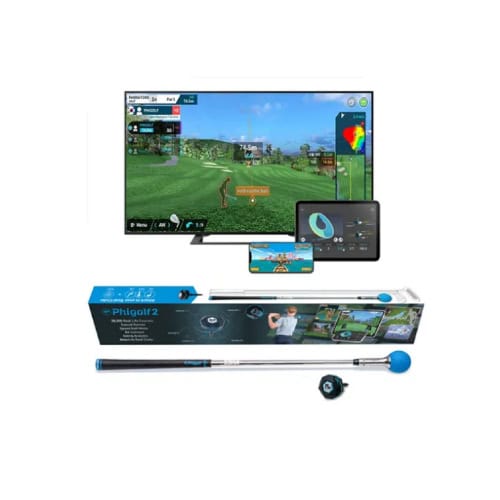
PhiGolf 2 steps it up with a similar impact sound and more detailed 3D swing animation. You can view your swing from multiple angles, even slow it down. It feels high-tech, but the results are mixed. Expect some inconsistency, especially with long clubs or fast swings.
Real-World Quirks and Common Issues
TruGolf tends to play it safe: shots go straight more often than they should. PhiGolf leans left. We noticed a built-in draw bias, especially with drivers.
Also, putting is twitchy on both. The game can’t feel the difference between a gentle stroke and a jab.
The Ball That Was Never Hit
Let’s be honest. Neither system tracks the ball. That means no spin, no launch angle and no feedback on strike quality. Every shot is treated like a center-face bomb, even if your swing said otherwise.
You won’t know if you hit it fat or thin. That’s the tradeoff. You get the convenience of swinging indoors, but lose out on true shot shape feedback.
Software Features and Course Variety
Digital golf lives or dies by the software. You can have the best swing in the world, but if the course looks like it was drawn in MS Paint or the feedback lags, you’ll lose interest fast.
TruGolf Mini with E6 Connect: High-Quality, High-Ceiling

E6 Connect isn’t some afterthought. It’s used by serious players and teaching pros. The graphics are clean and realistic. Courses are laser-scanned recreations of actual tracks, like St Andrews and Bandon Dunes. You get five courses and 17 ranges out of the box, but a free one-year upgrade unlocks 97+ full-length layouts.
Modes go beyond just stroke play. There’s a driving range, short game areas, mini-games, and even global online competitions. You can tweak wind, green speed, pin location, and more. It’s not flashy, but it’s polished and stable.
PhiGolf 2: Volume Over Polish

PhiGolf plays a different hand. It offers access to a jaw-dropping 38,000+ mapped courses. However, the detail isn’t always there; many are barebones with flat textures. You do get eight premium HD courses, but the leap in quality is obvious.
Still, variety wins. If you want to play a quick 6-hole “Rush” mode with the kids, an arcade-style “Crazy Birdie” game, stroke play, practice, tournaments, it’s all there. It leans toward casual and social golf.
Subscriptions and What You Really Get
TruGolf’s E6 subscription kicks in after the first year: $99 annually to keep the full course list. Without it, you drop back to five.
PhiGolf’s course access is tied to its app, with optional upgrades for HD courses. No forced subscriptions, but if you want E6 Connect support, you’ll need a separate license.
For golfers considering the added license, our in-depth TruGolf E6 review explains how the software performs in terms of realism, physics, and overall gameplay experience.
Multiplayer and Tournaments
Both support local and online multiplayer. TruGolf gives you a clean online competition flow through E6. PhiGolf shines in casual online matches—connect with friends via your phone and dive in. Just know that PhiGolf’s servers can be flaky on bad Wi-Fi. No one likes a laggy double bogey.
Hardware Quality and Durability
TruGolf Mini brings a two-foot “Impact Trainer” swing stick with a screw-in sensor. The stick’s weighted and balanced, so it doesn’t feel like a toy. You get that tactile “snap” at the bottom, which helps mimic real swing rhythm. It’s meant for use without a ball, which means fewer things to break. Just don’t try it with a real club unless you enjoy voiding warranties.
PhiGolf 2 also ships with a swing stick, though the star is the detachable sensor. The grip feels more like a real club. Some users even say they forget it’s not their 7-iron. It’s short, stable and doesn’t wobble mid-swing.
Both sticks can take a beating, provided the beating isn’t from a ceiling, wall or 12-year-old with something to prove.
Real Clubs? Tread Lightly
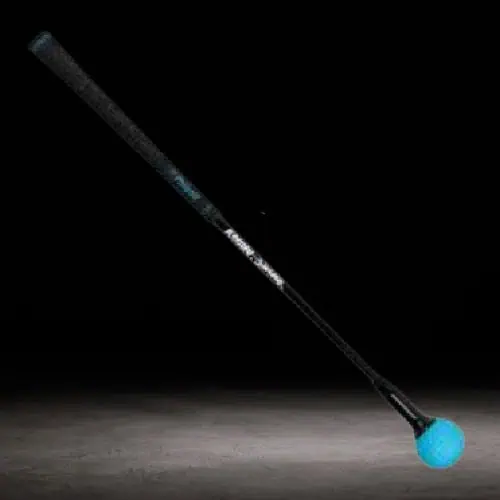
PhiGolf wins on flexibility. You can pull the sensor off and mount it on your own driver or wedge. That adds realism, but also risk. Real club swings mean real speed, and the sensor isn’t built like a tank. A flush hit into a net will be fine, but a shank into concrete won’t be.
TruGolf says you can mount their sensor to real clubs, too. But deep in the fine print, they mention it’s not recommended. Swinging hard with a full-length club can throw off readings or damage the gear. So, you’d better stick to the trainer.
Power and Battery Life
Both sensors last about four hours on a full charge. You’ll probably quit before they do. Charging takes about two hours, and both use standard USB cables. Nothing fancy here, just basic plug-and-play.
Maintenance and Longevity
Neither device needs babying. Just avoid water, high-impact crashes and tossing the sensor in your golf bag next to a divot tool. Users report long-term durability (months, sometimes years) when used for swing practice, not club demolition.
Device Compatibility and Setup
The best simulator in the world won’t help if it won’t connect, won’t load or won’t fit your space. Compatibility and simplicity matter.
Platform Support: Who Plays Nice with What
TruGolf Mini leans Apple. It’s built for iOS and works smoothly with iPhones, iPads and newer MacBooks (via E6 Connect). If you’re using Android, you’re out of luck. There’s no official support as of now. On the plus side, TruGolf recently added PC support, which opens the door to higher-res graphics and big-screen setups via HDMI or projector.

PhiGolf 2 plays both sides. It works on iOS and Android, giving you more flexibility. The app runs on smartphones and tablets, and you can mirror the display to your TV using Chromecast or AirPlay. There is no PC version, but mobile coverage is wide enough to get the job done. Just don’t expect console-like smoothness on older devices.
Setup and Pairing: Fast or Frustrating?
TruGolf Mini setup is quick, but you’ll need to register an E6 account, install the app and pair the sensor over Bluetooth. Most users get rolling in under 10 minutes. The sensor lights up, the app detects it and you’re swinging. That said, older iPads sometimes choke on graphics, and first-time E6 logins can feel clunky.
PhiGolf 2 is simpler. Open the app, connect via Bluetooth and start swinging. There’s a tutorial, and the interface walks you through calibration. No sign-up hoops. Just a few taps and you’re live. One thing to watch for is updates. If you haven’t launched the app in a while, plan for a long wait while it downloads the latest patch.
Space Needs: Realistic or Ridiculous?
TruGolf Mini was built for tight quarters. A hallway, spare bedroom or office works fine. The stick is under two feet long, so you don’t need a full backswing. As long as you’ve got enough clearance to avoid smashing a ceiling fan, you’re golden.
PhiGolf 2 gives you two choices: stick mode (compact) or real club mode (full swing). If you go with real clubs, you’ll need a net and at least 10 feet front-to-back.
Connectivity Hiccups: The Not-So-Fun Part
TruGolf’s E6 app is stable once set up, but we noticed Bluetooth drops, especially on older devices or when switching screens. PC mode is more reliable (less pretty, but it rarely disconnects).
PhiGolf’s app occasionally drops you mid-round, especially in online modes. Some blame Wi-Fi, some blame the app. Either way, it happens. Offline modes are safer if your router’s on the fritz.
Pros and Cons Summary

When it comes to swing stick simulators, no device hits every fairway. But each one has its sweet spots. The following breakdowns should help you choose where to tee off.
What TruGolf Mini Does Well
- Built for tight spaces: The short stick fits almost anywhere, even your office.
- Premium software: E6 Connect is smooth, polished and loaded with pro-grade features.
- Swing feel: That “click” at impact is oddly satisfying. You’ll catch yourself swinging just to feel it.
- PC support: You can run this on a large screen for full immersion without buying new gear.
Where TruGolf Mini Falls Short
- iOS only: No Android support. That’s a dealbreaker for some.
- Not great with real clubs: Technically possible, but discouraged.
- Subscription pressure: The first year is loaded, then you hit the paywall.
What PhiGolf 2 Does Well
- Flexibility: Works with Android, iOS and even real golf clubs.
- Course quantity: With over 38,000 layouts, you’ll never run out of holes to play.
- Arcade fun: The mini-games and modes like “Rush” are perfect for family nights.
- Sensor design: Clip it to your own club for more realism without needing a full sim setup.
Where PhiGolf 2 Misses
- Draw bias: Left-hitters beware. The system leans hard in that direction.
- Inconsistent putting: Touch-based shots don’t always translate well.
- No PC version: You’re stuck with mobile. No desktop, no native big-screen app.
Best Use Cases
- TruGolf Mini: Great for golfers who want to focus on swing tempo and mechanics without needing a full swing or space.
- PhiGolf 2: Better suited for casual users, families or those who want to mix entertainment with light practice.
Price Point & Where to Buy?

TruGolf Mini usually sells for $249 to $299. Some kits include a one-year E6 Connect subscription. PhiGolf 2 costs about $319. Here are our recommended retailers to get the devices:
Official Websites
Buying direct often means you’re getting the latest firmware, full manufacturer support and access to exclusive bundles or early product updates. It’s also the safest route if you want warranty coverage without jumping through third-party hoops.
Amazon
Phigolf 2 is available on Amazon. You’ll often find competitive prices, fast shipping and user reviews to guide your choice.
Frequently Asked Questions
We have compiled some common questions about the two devices to help you make your final decision.
Can I attach the sensor to my own golf clubs with both devices?
Yes, but with different results. PhiGolf 2 is built for it—just clip the sensor onto your own club and swing away. TruGolf Mini allows it too, but the manufacturer advises against it. Real club swings could skew data or damage the sensor over time.
Which simulator is better for putting practice?
Neither is great. PhiGolf’s putting is extra sensitive—blink and you’ve rolled it ten feet past. TruGolf’s version is less frustrating but still lacks the touch feedback you’d get on a real green. Most users end up turning on auto-putt.
How accurate are these devices compared to a launch monitor like Garmin R10?
Not even close. Garmin R10 tracks the actual ball. TruGolf Mini and PhiGolf 2 track your swing and simulate the result. they’re useful for tempo and path, not for real distance or spin accuracy.
Is there any risk of damaging the sensor with full swings?
Yes, especially if you’re using real clubs. Both sensors are solid but not indestructible. Foam balls are fine, but hitting a wall or chunking a mat is a gamble.
Are either of these simulators good for kids or beginners?
PhiGolf 2 shines here. The games are easy to understand, the modes are fun and the learning curve is gentle. TruGolf Mini is more technical and may be better suited for adults who want focused reps.
Do I need a subscription to access all the courses on PhiGolf 2?
Not exactly. You get thousands of mapped courses for free, but the premium HD versions cost extra. E6 Connect access (if used) is also a separate subscription.
Can either device be used without an internet connection?
Partially. TruGolf Mini lets you use practice modes offline after the initial setup. PhiGolf 2 requires internet for most features, especially online play and course loading. Forget the Wi-Fi, and you’re stuck on the range.
Final Verdict: Which Swing Stick Simulator Is More Accurate?
TruGolf Mini is the better pick if accuracy matters most. It delivers more reliable swing metrics, smoother software integration and a training-first experience that helps build consistency. If you’re focused on tempo, club path and feedback you can trust, this is the safer bet.
PhiGolf 2 wins on flexibility and entertainment. It supports real clubs, Android devices and packs in a huge variety of game modes and courses. It’s better for casual use, multiplayer fun and light swing practice without overthinking the numbers. If you’d like a deeper breakdown of features, performance, and use cases, check out our detailed PhiGolf 2 review.
Both work well in tight spaces and offer solid value under $300. But if your goal is focused improvement, go Mini. If you want to keep things fun and flexible, PhiGolf 2 won’t disappoint. Choose based on how you plan to swing, not just what you want to see on screen.



